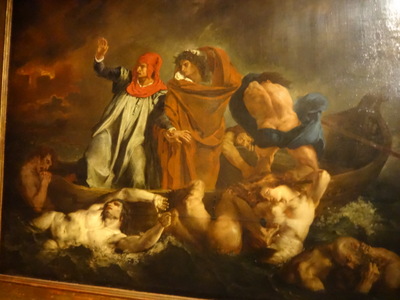
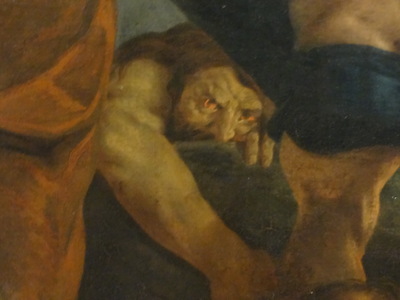 Once the guide arrived, checked us out on the headsets, and led us up another back stairway to the entrance, the exhibition was quite good. Not everyone there was part of a tour, and I have no idea how they ever found their way in.
Once the guide arrived, checked us out on the headsets, and led us up another back stairway to the entrance, the exhibition was quite good. Not everyone there was part of a tour, and I have no idea how they ever found their way in.Monday, 18 June, Over the barricades with Delacroix (and about 500,000 of our closest friends)
Written 8 July 2018
Monday was the day we had 11:30 a.m. reservations for the Delacroix retrospective at the Louvre, so David got up early (or what he considers early) for breakfast, and we set off about 10 a.m., allowing plenty of time to buy our Louvre general admission tickets. No mishap in the metro this time, so we were there in good time and made our way from the Palais Royal station toward the basement of the Carousel mall, where we were met with a scene that "howling bedlam" does not begin to describe. The place was full of people hurrying to and fro. The only stationary ones were standing in a queue three or four abreast that stretched out of sight around corners in both directions!
David headed upstream to find the end of the line and join it while I walked downstream to reconnoiter. At the head of the line, which led to the security checkpoint, I found that same little wooden table, again manned by just one guy looking into handbags while his armed colleague looked on. Every two or three minutes, a busload of tourists led by a guide with a fistful of prepurchased tickets would arrive from a different direction, and the main line would be halted while they passed through the checkpoint. Dismayed, I followed the queue back upstream, looking for David, and finally found him about four city blocks away and up a staircase, holding a place in a line that hadn't moved 10 feet since he got there.
Now what? I had seen signs advertising prepurchased "billets coupe-fil"—line-cutting tickets—but I didn't know whether ours were line-cutters or not, since we didn't yet have general admission tickets. Finally, I hunted up a guard, showed him the tickets, and was told that yes, they were but that we would have to go back that way and around (gesturing expansively) to the pyramid, where the special line for ticket holders was. Since we had only an hour or so left before our reservation, and this line was clearly going to take at least two days, we had no choice, so we went "back that way," which proved to lead only to an exit to the Carousel gardens, and around, above ground, to the pyramid, where sure enough, we found a line outdoors on the parvis, for people with tickets. We breezed through that, took the escalators back down into the pyramid, and reported to the new ticket counters I had spotted earlier. Every window and kiosk had about six parties waiting, so we chose one at random, and the nice lady behind the window sold us general-admission tickets. I'd seen posters for the Delacroix exhibition but absolutely no indication of where it might be. The lady behind the window gave us semicoherent instructions to go behind (not up!) the escalators and into "Group Sales." Okay, whatever.
In Group Sales, we suddenly found ourselves waist-deep in shrieking school children, busy stowing their backpacks in special group lockers. Wading to the desk, we showed our Delacroix tickets and were directed back along a long curving hallway to a desk that issued us headsets and receivers so that we could hear our guide (apparently the reservation included a guided tour!). They then directed us partway back along the curved hallway and up a flight of stairs, where we were to locate and wait in "room 3." We got there and settled in with five minutes to spare!

 Once the guide arrived, checked us out on the headsets, and led us up another back stairway to the entrance, the exhibition was quite good. Not everyone there was part of a tour, and I have no idea how they ever found their way in.
Once the guide arrived, checked us out on the headsets, and led us up another back stairway to the entrance, the exhibition was quite good. Not everyone there was part of a tour, and I have no idea how they ever found their way in.
As the guide pointed out, she couldn't possibly tell us about every one of the 180 works on display, so she just concentrated on a few. The one she started with was his first major work, this large painting of Dante (in the red hood) accompanied by Virgil (in the brown cloak) passing in their boat through the level of hell reserved for those guilty of the sin of anger. (The label said that Delacroix borrowed the "powerful nudes" of Michaelangelo and the "warm colors" of Rubens.) Note in particular the guy sinking his teeth into the boat's transom. At the right is a close-up of another angry guy trying to cimb into the boat between Virgil and the bare-backed oarsman. He's staring straight out at the viewer—"Yes, I'm angry at you, too!"
Greece standing on the ruins.
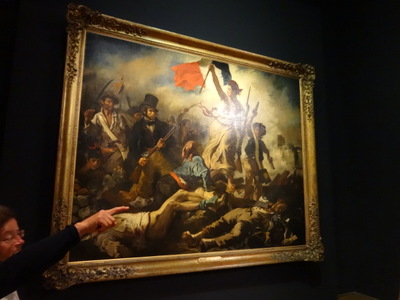
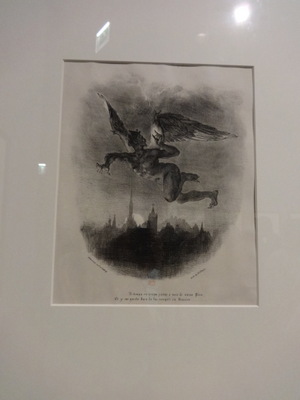 At the left here (marred, alas, by the glare) is perhaps Delacroix's most widely known work, Liberty Leading the People (originally called something like "The Barricades.") She's wearing a red Phrygian cap, even though this painting depicts not the "French Revolution" of 1789 but a later one in the 19th century. (France has had three, four if you count the Paris Commune, and this is the one covered in Les Miz. The boy to the right of Liberty is often identified with Gavroche, but in fact, this painting was done a good 30 years before Les Miz was written.) The guide went on about how important it was that the painter had chosen to place the viewer on the government side of the barricade, with the revolutionaries coming at him, and thus gave him only two choices, being "with us or against us." Personally, I think the painter chose this viewpoint because Liberty would not have been nearly as impressive viewed from behind.
At the left here (marred, alas, by the glare) is perhaps Delacroix's most widely known work, Liberty Leading the People (originally called something like "The Barricades.") She's wearing a red Phrygian cap, even though this painting depicts not the "French Revolution" of 1789 but a later one in the 19th century. (France has had three, four if you count the Paris Commune, and this is the one covered in Les Miz. The boy to the right of Liberty is often identified with Gavroche, but in fact, this painting was done a good 30 years before Les Miz was written.) The guide went on about how important it was that the painter had chosen to place the viewer on the government side of the barricade, with the revolutionaries coming at him, and thus gave him only two choices, being "with us or against us." Personally, I think the painter chose this viewpoint because Liberty would not have been nearly as impressive viewed from behind.
Delacroix was a very versatile artist and was often commissioned to do illustrations. Here, at the right, is his lithograph of Mephistopheles in the Air from Goethe's Faust.
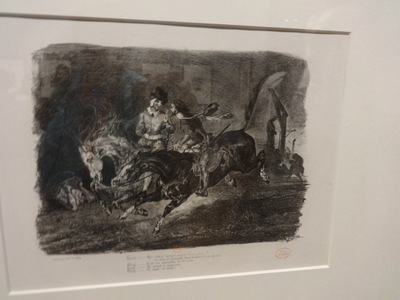
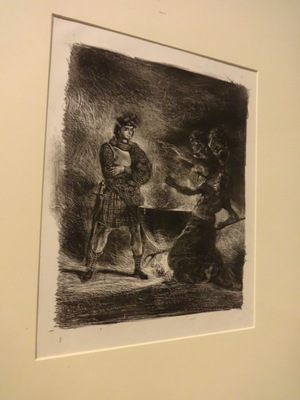 At the left is Faust and Mephistopheles Galloping in the Night of the Sabbath (also from Goethe),
At the left is Faust and Mephistopheles Galloping in the Night of the Sabbath (also from Goethe),
At the right is MacBeth Consulting the Three Witches, rendered not by the usual method of incising a bare stone surface but by covering the entire surface with a black coating and incising that.
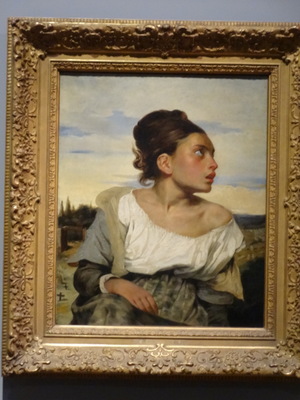
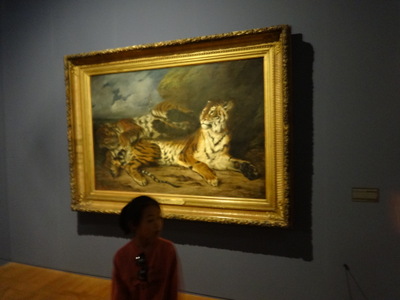 Almost as famous as "Liberty" is this portrait, Young Orphan at the Cemetery (apparently originally titled "young beggar"). He used this image again, in must less detailed and finished form, for one of the minor characters (at the left-hand edge) in a much larger painting we saw, called The Massacre at Chios. Delacroix was apparently much moved by the violence taking place in Greece at the time, and several of his paintings were on that theme, including an allegory of Greece Standing on the Ruins of Missolonghi.
Almost as famous as "Liberty" is this portrait, Young Orphan at the Cemetery (apparently originally titled "young beggar"). He used this image again, in must less detailed and finished form, for one of the minor characters (at the left-hand edge) in a much larger painting we saw, called The Massacre at Chios. Delacroix was apparently much moved by the violence taking place in Greece at the time, and several of his paintings were on that theme, including an allegory of Greece Standing on the Ruins of Missolonghi.
And to help round out his image of versatility, he painted these two realistic and life-size tigers. He apparently painted a number of scenes featuring tigers, but this was the only one included in the exhibition and, from the images I've seen, the best.
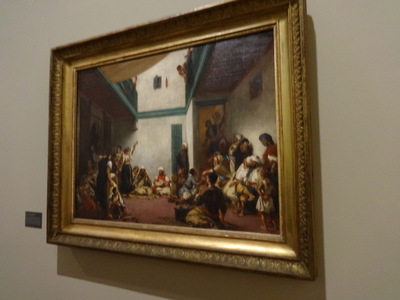
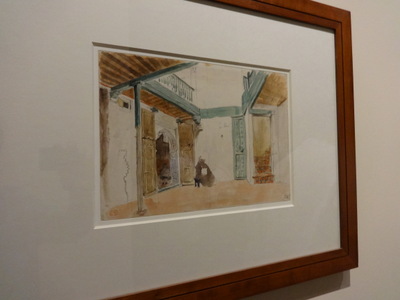 Delacrois always wanted to go to Rome, but he could never afford it. Instead, his work was heavily influenced by the two trips he did get to make, as a result of the generosity of traveling friends: to England and to north Africa. Schlepping all the paraphernalia necessary to oil painting around north Africa was difficult, so on the road he often resorted to the watercolors, much more portable. Again his versatility shows.
Delacrois always wanted to go to Rome, but he could never afford it. Instead, his work was heavily influenced by the two trips he did get to make, as a result of the generosity of traveling friends: to England and to north Africa. Schlepping all the paraphernalia necessary to oil painting around north Africa was difficult, so on the road he often resorted to the watercolors, much more portable. Again his versatility shows.
The friends who took him to north Africa were Jewish, and his work there was heavily influenced by the world he had access to as a result. At the left here is a view of a Jewish wedding. Our guide hastened to point out that the prominent dancing figure is not the bride and that the bride was concealed behind the partially open window at the top center.
I especially liked the simple watercolor at the right, which could actually be set in the same location as the wedding.
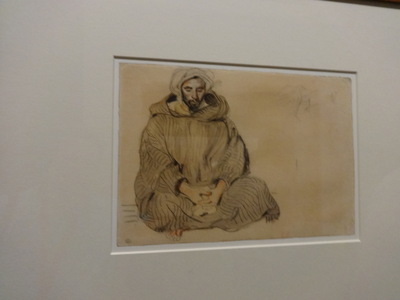
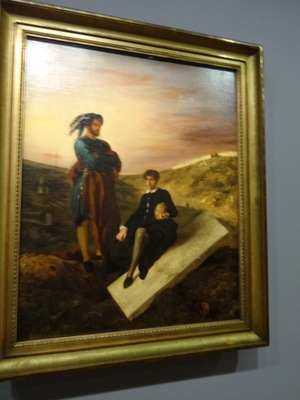 I also liked this color-washed drawing, descriptively entitled Arab Sitting Tailor-fashion, Facing Forward, with Hands Crossed.
I also liked this color-washed drawing, descriptively entitled Arab Sitting Tailor-fashion, Facing Forward, with Hands Crossed.
Presumably his travel in England, together with his reputation as a lithographer, won him commissions to illustrate a number of English-language works. The oil painting at the right (refused exhibition at the 1835 Salon) is of Hamlet and Horatio in the cemetery.
A major work resulting from his north African travels purports to depict three women in an Arab harem, bare-faced. Although contemporary accounts relate that Delacroix was given acess to a harem, authorities find it implausible that a non-Arab, non-Muslim stranger would be given the chance to see (and paint for public display!) Arab women without their veils. Their speculation is that Delacroix did in fact see a harem, empty at the time, and that young Jewish (and therefore unveiled) women posed later for the three figures.
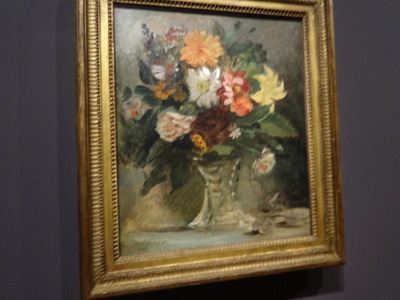
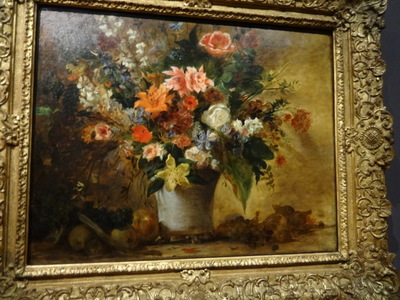 Delacroix even painted, and did a pretty good job with, the floral still lives so dear to our hearts. I also liked his still life of a hare and lobsters, set on a beach, which was apparently revolutionary in including both terrestrial game and seafood, together with the apparatus for catching both.
Delacroix even painted, and did a pretty good job with, the floral still lives so dear to our hearts. I also liked his still life of a hare and lobsters, set on a beach, which was apparently revolutionary in including both terrestrial game and seafood, together with the apparatus for catching both.
The exhibition included much, much more than I've shown here. He painted mythological scenes for ceilings, battle scenes, Cleopatra and the peasant who brought her the asp, Medea preparing to slaughter her own children, a lion hunt in which the lions appear to be getting the upper hand, crucifictions, the shipwreck of Don Juan, and a huge "Death of Sardanapalus" (In which Sardanapalus reclines at his ease watching while his slaves slaughter his harem at his orders, preparatory to his own later suicide). His watercolors and lithographs are of manageable size, but his oil paintings are enormous, like 9 x 12 feet!
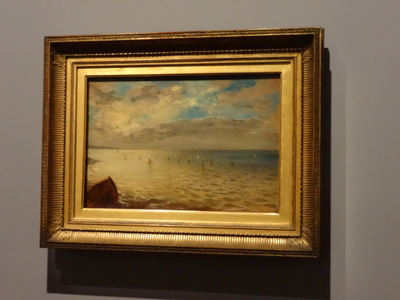
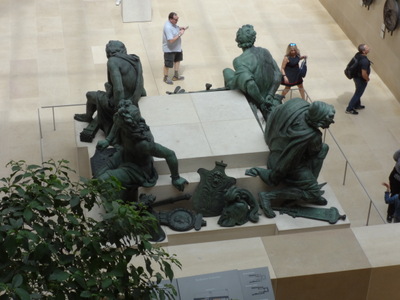 Finally, just to round things out, here's the sunset shot, the only landscape included in the exhibition.
Finally, just to round things out, here's the sunset shot, the only landscape included in the exhibition.
At the right is a shot down into the sculpture court from a window in the staircase as we made our way back down, looking for lunch.
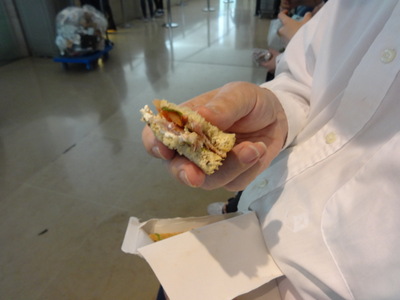
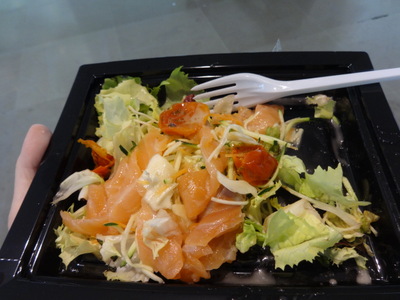 Lunch was not easy to come by, nor was a place to eat it. One eatery within the museum was closed, and the others had long lines. Every table, chair, bench, and ledge was taken, and people were sitting on the floor leaning back against the walls with their feet in front of them.
Lunch was not easy to come by, nor was a place to eat it. One eatery within the museum was closed, and the others had long lines. Every table, chair, bench, and ledge was taken, and people were sitting on the floor leaning back against the walls with their feet in front of them.
We finally settled for a grab-and-go place and managed to score leaning room against a parapet on a balcony overlooking the main floor of the pyramid. David had a "club sandwich" (in French, a "club sandwich" seems to be any sandwich made on rectangular sliced bread), which he pronounced not very good, and I had salad of lettuce and tomato topped with lots of julienned raw vegetables and slices of smoked salmon, which wasn't bad.
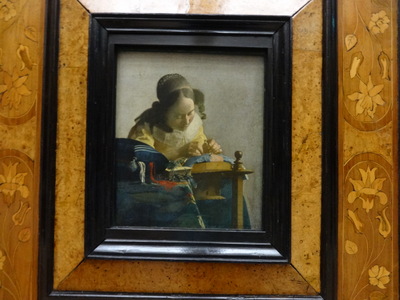
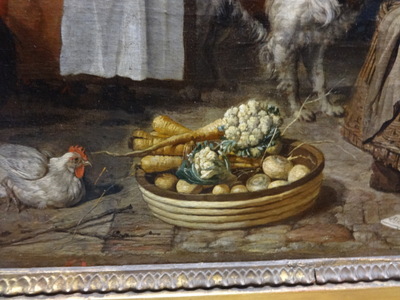 After lunch, since we were already there, and our feet weren't yet entirely shot, we decided to go have a look at some Dutch masters before heading home, so we consulted the folding floor plan and headed to level two of the Richelieu wing, room 837.
After lunch, since we were already there, and our feet weren't yet entirely shot, we decided to go have a look at some Dutch masters before heading home, so we consulted the folding floor plan and headed to level two of the Richelieu wing, room 837.
There we found, as promised, this beautiful Vermeer Lacemaker, as well as many fine portraits and still lives. The one at the right illustrates a basic difference between northern and southern European still-live painters. In the south, they paint melons, pomegranates, citrus, apples, pears, grapes, etc. spread on sumptuous tables, sometimes with parrots or monkeys. The Dutch, on the other hand, protray cauliflower, turnips, potatoes, and parsnips in a wooden basket set on cobblestones with a live chicken and a dog.
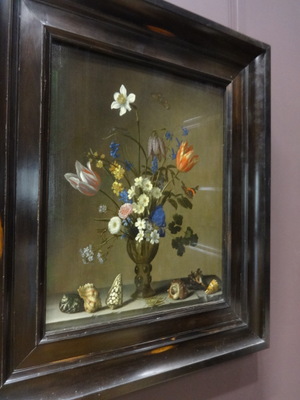
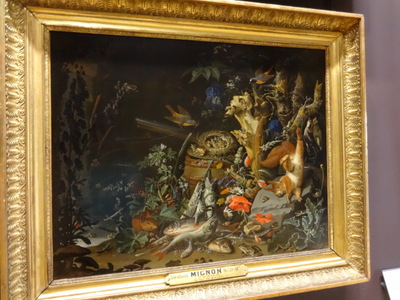 We love the Dutch way with flowers, which they protray in exquisite and realistic detail, together with seashells, insects, and other natural-historical objects.
We love the Dutch way with flowers, which they protray in exquisite and realistic detail, together with seashells, insects, and other natural-historical objects.
And they do sumptuous arrays of game, like this one by Abraham Mignon, which is actually entitled The nest of redtails because of the bird's nest in the middle. That mom is going to have her work cut out to feed the six hungry nestlings in the nest, plus the one sitting next to it! This painting precedes Delacroix's time, but no one seemed to think it revolutionary that it includes both a dead squirrel and a bunch of fish.
They also had a fine de Heem still life, but I didn't think it measured up to the magnificent one at the Ringling in Sarasota, a poster of which hangs in our dining room.
Since our visit there, I've poked around a little on the internet, trying to figure out why the museum was so calm around midday on a Friday and a screaming madhouse around midday the following Monday. We were frequently reminded during this trip and at other times that national museums, like the Louvre, the Grand Palais, and the Picasso Museum are all closed on Tuesdays. City museums, like the Orsay, the Carnavalet, and the Petit Palais are all closed on Mondays. So on Mondays the Louvre is hopelessly crowded because the Orsay is closed, and on Tuesdays, the Orsay is slammed because the Louvre is closed. Be warned!
Written 9 July 2018
Back at the apartment, before we went out again for dinner, we talked about the problem of getting the stitch removed from David's eyebrow—the doctor at the airport had said " to 10 days." The He had recommended that we inquire at a pharmacy; if someone there couldn't do it, they could probably direct us to the office of a nearby nurse who could. But when faced with the prospect of getting up relatively early on Monday morning to go to a pharmacy, David said, "Why don't you just do it now." So I got out the itty-bitty scissors and teeny-tiny tweezers from my Swiss army purse knife, snipped the stitch, and twitched it out. No muss, no fuss. I only cut off a couple of eyebrow hairs in the process.
The eyebrow healed up quickly and cleanly, but his hands, both of which got scraped and bruised pretty badly were still stiff and sore.
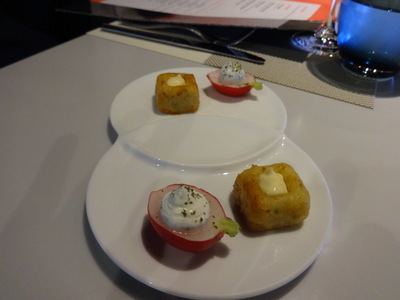
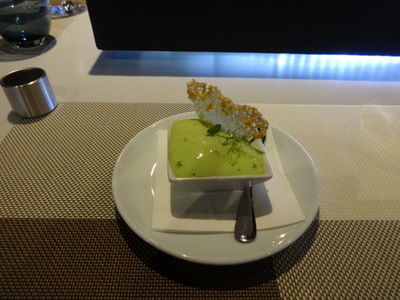 Our Monday night dinner was at Chiberta, an outpost of the Guy Savoy empire (his main restaurant is in the basement of the Paris Mint), pretty much across the street from the Publicis Drugstore. It was another case in which they had no room for us in the dining room but could put us at the bar, looking into the kitchen. This bar wasn't as comfortable as the one at Joël Robuchon. For starters, the brass rail on which you're supposed to rest your feet was too low, or perhaps the stools were too high, so we had to rest our feet all night on the rungs of the stools and had trouble adjusting our distance from the table-top. As at the other place, a whole stack of shelves, this time over the flattop, were given over to useless decorative arrangements. I wonder whether the cooks find that annoying, having to give up so much otherwise useful space.
Our Monday night dinner was at Chiberta, an outpost of the Guy Savoy empire (his main restaurant is in the basement of the Paris Mint), pretty much across the street from the Publicis Drugstore. It was another case in which they had no room for us in the dining room but could put us at the bar, looking into the kitchen. This bar wasn't as comfortable as the one at Joël Robuchon. For starters, the brass rail on which you're supposed to rest your feet was too low, or perhaps the stools were too high, so we had to rest our feet all night on the rungs of the stools and had trouble adjusting our distance from the table-top. As at the other place, a whole stack of shelves, this time over the flattop, were given over to useless decorative arrangements. I wonder whether the cooks find that annoying, having to give up so much otherwise useful space.
After long study of the menu, David decided on the seven-course menu tasting menu, whereas I wanted to order à la carte. Because the menu made no statement to the contrary (most places serve the tasting menu only if everyone in the party has it), they let us do it. The number of courses didn't match up, but the waitstaff pushed and pulled at the timing and made things come out pretty close to even.
The initial amuse-bouche was tiny single-celled savory waffles with a dab of sauce in the middle and half radishes with cream on top.
At the right is David's first course: "peas in a variety of textures with sweet almonds." The foamy cold pea soup had whole peas and other things hidden in it.
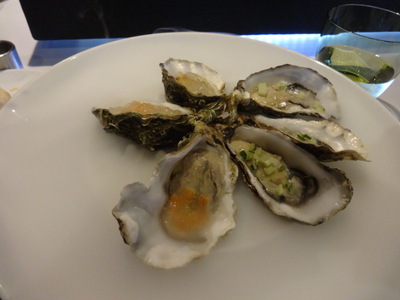
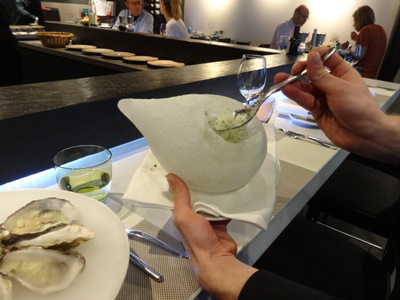 My first course was Ronce "David Hervé'" oysters (I assume that's the location and producer) in two preparations: with iced sauce and with a granité of cucumber and cilantro. The first came already gelled into their iced sauce, but the granité was applied to the other three at the table, on top of the tiny diced cucumber already on them. It was served from this amazing container, which I think was actually made of ice. The ones in the iced sauce were good, but the others, wow! That cucumber-cilantro combination was terrific and went perfectly with the oysters! That was a real winning combination.
My first course was Ronce "David Hervé'" oysters (I assume that's the location and producer) in two preparations: with iced sauce and with a granité of cucumber and cilantro. The first came already gelled into their iced sauce, but the granité was applied to the other three at the table, on top of the tiny diced cucumber already on them. It was served from this amazing container, which I think was actually made of ice. The ones in the iced sauce were good, but the others, wow! That cucumber-cilantro combination was terrific and went perfectly with the oysters! That was a real winning combination.
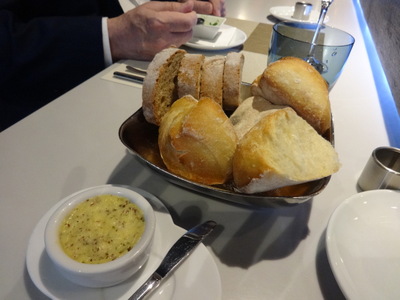
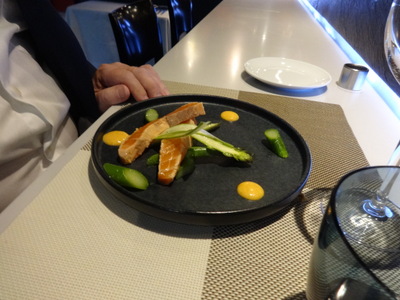 Here's the bread they brought us, served with algae butter.
Here's the bread they brought us, served with algae butter.
David's next course was salmon trout, gravlax style, decorated with asparagus sliced different ways. He said it was good, but I'm afraid I was too much into my oysters at the time to take much notice.
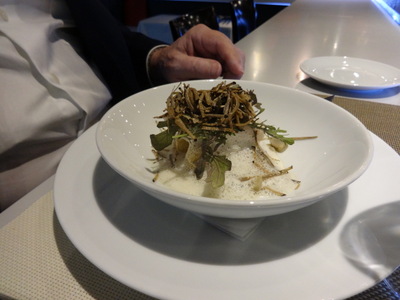
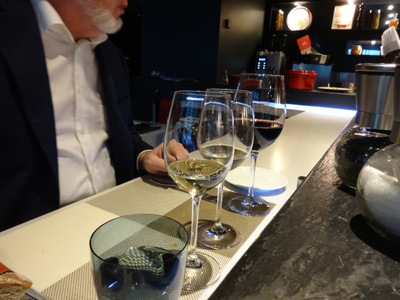 Next he had sole from the Vendée (an Atlantic coastal region south of Nantes and north of La Rochelle) with artichokes and tiny potatoes, mostly hidden under a foamy sauce and a thatch of shredded summer truffles.
Next he had sole from the Vendée (an Atlantic coastal region south of Nantes and north of La Rochelle) with artichokes and tiny potatoes, mostly hidden under a foamy sauce and a thatch of shredded summer truffles.
And at the right is the array of glasses in front of him after three courses. He chose to have the recommended wine pairings with the menu, so they poured him a small glass with each dish.
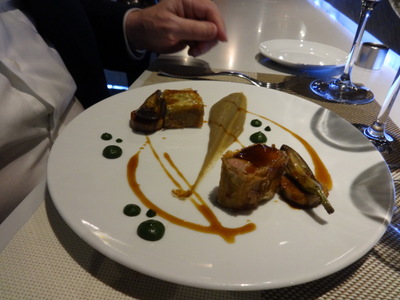
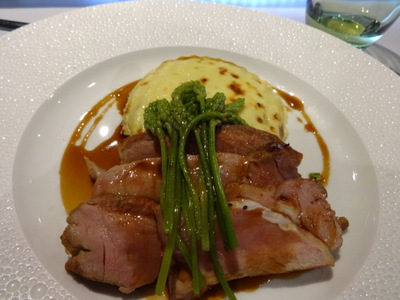 David's meat course was baby lamb from Aveyron, roasted in a crispy crust with "basil condiment" and accompanied by stewed halves of baby eggplant.
David's meat course was baby lamb from Aveyron, roasted in a crispy crust with "basil condiment" and accompanied by stewed halves of baby eggplant.
Mine was the special of the night, slices of veal chop topped with wild asparagus. Behind it is a dome of grilled mac and cheese (made, as is usual in France, with Gruyère rather than cheddar), resting on a bed of braised shallots. Yum!
For the cheese course, which we ate before I thought to photograph it, was fresh St. Maur, served with a quenelle of "olive pesto." St. Maur is a chevre, typically a horizontal log with a dowel through the center and typically ashed and aged. This one was unashed and was newly made, without aging. The olive pesto went perfectly with it!
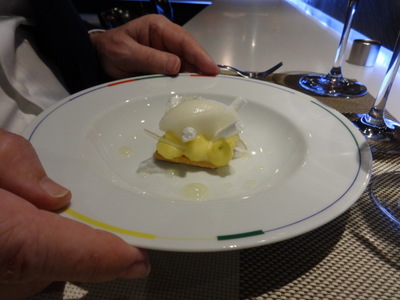
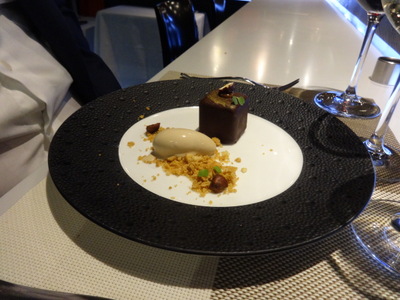 David's predessert was a small square cookie topped with little puffs of lemon custard, in turn topped with a quenelle of lemon sorbet and decorated with little sheets of melted sugar and rods of crisp meringue.
David's predessert was a small square cookie topped with little puffs of lemon custard, in turn topped with a quenelle of lemon sorbet and decorated with little sheets of melted sugar and rods of crisp meringue.
His dessert was a chocolate-hazelnut confection with praline ice cream.
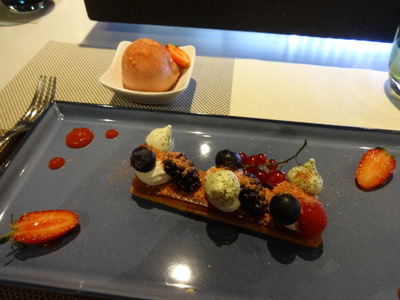
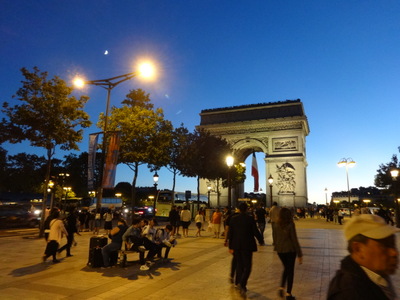 Mine was yet another variation on strawberries. The base was a layered affair of cookie, jelly, and cream, topped with strawberries, blueberries, blackberries, red currants, cookie crumbs, and meringue puffs, accompanied by a rather watery strawberry sorbet.
Mine was yet another variation on strawberries. The base was a layered affair of cookie, jelly, and cream, topped with strawberries, blueberries, blackberries, red currants, cookie crumbs, and meringue puffs, accompanied by a rather watery strawberry sorbet.
Emerging from the restaurant, I got this shot of the Arc de Triomphe at twilight.
I've tried a couple of times to look up where or what "Chiberta" is, but all I've found is that it's the name of a very upscale golf-attire company as well as a very upscale purveyer of equestrian saddles and bridles. And of this restaurant.
My fitbit was delighted with me. I've had more 8000-step days in a row than ever before (every day but one since our arrival), and today I it awarded me a Redwood Forest Badge for climbing more than 25 flights of stairs in a day (35 altogether; Paris subways are really, really wheelchair unfriendly).
Previous entry List of Entries Next entry